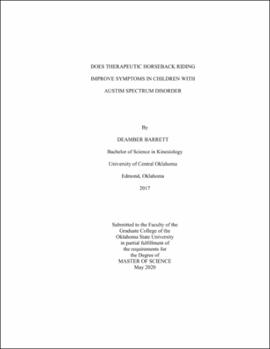| dc.description.abstract | The purpose of this study was to determine if an 8-week therapeutic horseback riding program would decrease symptoms among children with ASD. The researcher hypothesized that the program would cause a decrease in the five subscales examined in this study: irritability, social withdrawal/lethargy, stereotypy, hyperactivity/noncompliance, and inappropriate speech. Participants in the study were parents of children age 5-18 with a current diagnosis of Autism Spectrum Disorder and planned to participate at a facility in a southwestern city in the U.S. Four participants of 5 children met the criteria and consented to participate. Participants completed a 58-item assessment, the Aberrant Behavior Checklist-Community, prior to starting and after their child completed the program. The assessment was used to evaluate the severity (on a scale of 0-3) of the observed behaviors of their child. Each item was associated with 1 of the 5 subscales in this study. The total of each item from the participants was used to assess the results of the study. Two non-parametric tests were used, the Spearman's Rho Correlation Coefficient and the Wilcoxon Signed Rank Test. Spearman's Rho was used to determine if there was a correlation between any of the subscales within the pre-assessments and again within the post-assessments. Wilcoxon was used to determine whether there was a change between the pre-assessment and post-assessment ratings. Within the pre-assessment subscales, statistically significant results yielded a very strong, positive correlation was found between Social Withdrawal/Lethargy and Inappropriate Speech (rs = .949, a = .026). The post-assessment subscales yielded, a very strong, negative correlation between Stereotypy and Hyperactivity/Non-compliance (rs = -.873, a = .005) and a perfect, positive correlation between Stereotypy and Inappropriate Speech. The results also yielded a statistically significant decrease in social withdrawal/lethargy (z = -2.864, a = .004) and a trend for increasing stereotypic behaviors (z = -.857, a = .063). Recommendations for future results include: larger sample size, recruiting parents of children participating for the first time, including race, gender, and socioeconomic status in the demographics, additional sessions each week and working with instructors to design interventions targeting the 5 subscales, contacting multiple facilities throughout the U.S. | |
